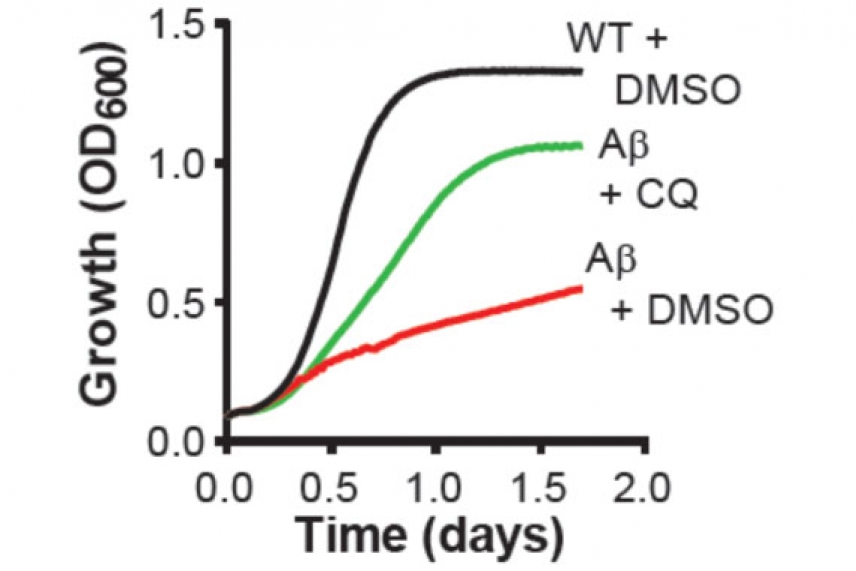Yeast model reveals Alzheimer’s drug candidate and its mechanism of action

Growth curves of wild type and amyloid-beta strains treated with clioquinol
Courtesy of the Proceedings of the National Academy of Sciences (PNAS)
CAMBRIDGE, Mass. – Using a yeast model of Alzheimer’s disease (AD), Whitehead Institute researchers have identified a drug that reduces levels of the toxic protein fragment amyloid-β (Aβ) and prevents at least some of the cellular damage caused when Ab accumulates in the brains of AD patients.
“We can use this yeast model to find small molecules that will address the underlying cellular pathologies of Alzheimer’s, an age-related disease whose burden will become even more significant as our population grows older,” says Kent Matlack, a former staff scientist in Whitehead Member Susan Lindquist’s lab. “We need a no-holds-barred approach to find effective compounds, and we need information about their mechanism of action quickly. Our work demonstrates that using a yeast model of Ab toxicity is a valid way to do this.”
The U.S. National Institute on Aging estimates that 5.1 million Americans may have AD, the most common form of dementia, which progressively robs patients of their memories, thinking, and reasoning skills. Research focused on the disease has been hampered by the affected cells’ location in the brain, where they cannot be studied until after an AD patient’s death. To explore the cellular processes compromised by AD, researchers in Lindquist’s lab created a yeast model, first described in the journal Science in 2011, that mimics in vivo the accumulation of Aβ that occurs in the human disease.
In the current research, which is described in this week’s issue of the journal Proceedings of the National Academy of Sciences (PNAS), a team of scientists in Lindquist’s lab used the yeast model to screen approximately 140,000 compounds to identify those capable of rescuing the cells from Aβ toxicity. One of the more promising classes of compounds has previously shown efficacy in animal models of AD and is about to complete a second phase II trial for AD. The mechanism by which the best-studied member of this class, clioquinol, targets Ab within the cell – where a large portion of it is produced in neurons – was unclear.
“Our work in the yeast model shows that clioquinol decreases the amount of Aβ in the cells by 90%,” says Daniel Tardiff, a scientist in Lindquist’s lab. “That’s a strong decrease, and it’s dose-dependent. I’ve tested a lot of compounds before, and I’ve never seen anything as dramatic.”
Clioquinol chelates copper, meaning that it selectively binds the metal. In many AD patients, Aβ aggregates have higher concentrations of copper and other metals than normal, healthy brain tissue. Biochemical experiments also show that copper makes Aβ more toxic.
With clioquinol’s chelation capabilities in mind, Tardiff and Matlack, co-authors of the PNAS paper, tested clioquinol’s effect on Aβ-expressing cells in the presence of copper. The drug dramatically increased the degradation of Aβ in a copper-dependent manner, and even restored the cellular protein-trafficking process known as endocytosis, which is disrupted in both the yeast model and in AD-affected neurons.
“The clioquinol probably has a slightly higher affinity for copper than Aβ does, but it is not a strong enough chelator to strip the cell’s normal metalloproteins of the copper they need,” says Matlack. “From what we’ve seen in the yeast model, we think the drug pulls the copper away from Aβ. That would alter Aβ’s structure and likely make it more susceptible to degradation, thus shortening its half-life in the cell.”
The results from clioquinol in yeast and the clinical potential of closely related compounds are promising. While these compounds are not yet ready to serve as AD drugs in the clinic, the identification of an AD-relevant compound and cellular pathology – along with the Lindquist lab’s previous identification of human AD risk alleles that reduce Ab toxicity in yeast – suggests that this discovery platform will continue to yield information and lead to more compounds with equal or greater effectiveness, some of which will hopefully make a difference in human disease.
“It is important to remember that this class of compounds was shown to work in mouse models and in a limited human trial,” says Lindqust, who is also a professor of biology at MIT and an investigator of the Howard Hughes Medical Institute. “We have validated the yeast model and shown that we can find such compounds at a speed that was inconceivable before—indeed we found some compounds that look even more effective.”
This work is supported by the Howard Hughes Medical Institute, National Institutes of Health (R03 Grant DA032472), the Ellison Foundation, National Research Service Award (NRSA F32NS061419), the JPB Foundation, and the Edward N. and Della L. Thome Memorial Foundation.
* * *
Susan Lindquist’s primary affiliation is with Whitehead Institute for Biomedical Research, where her laboratory is located and all her research is conducted. She is also a professor of biology at Massachusetts Institute of Technology and an investigator of the Howard Hughes Medical Institute.
* * *
Citation:
Matlack, K. E.*, Tardiff, D. F.*, Narayan, P., Hamamichi, S., Caldwell, K. A., Caldwell, G. A., & Lindquist, S. (2014). Clioquinol promotes the degradation of metal-dependent amyloid-β (Aβ) oligomers to restore endocytosis and ameliorate Aβ toxicity. Proceedings of the National Academy of Sciences, 111(11), 4013-4018.
* These authors contributed equally.
Contact
Communications and Public Affairs
Phone: 617-452-4630
Email: newsroom@wi.mit.edu


